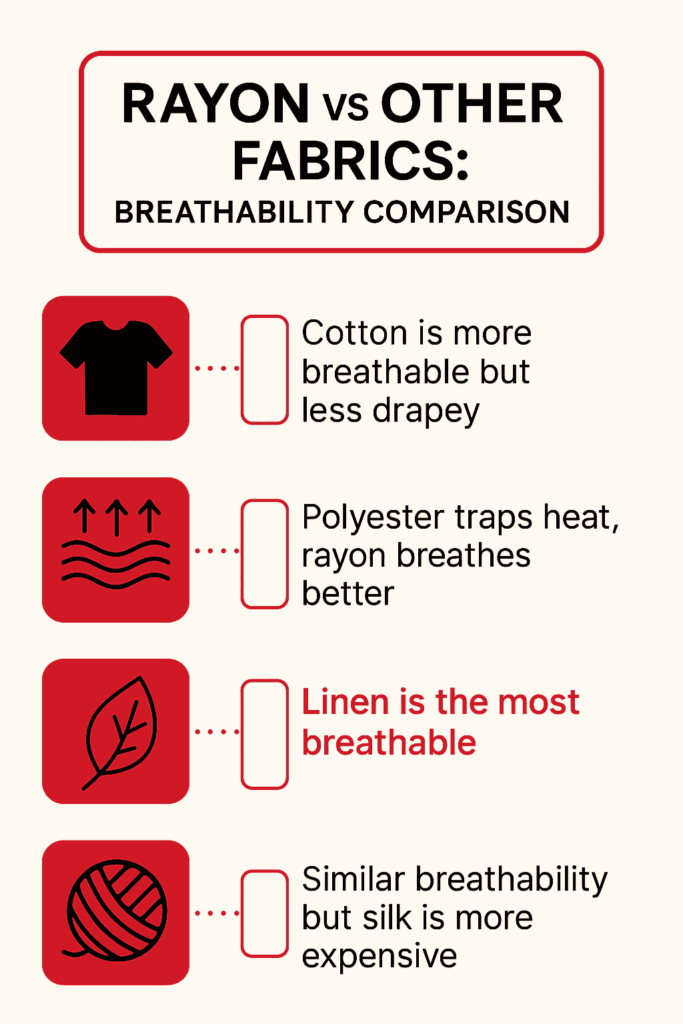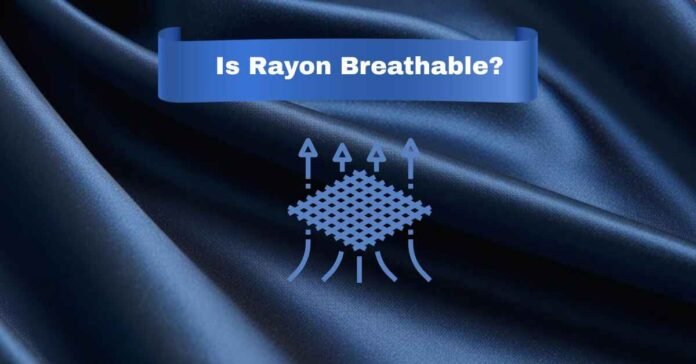Rayon is a naturally sourced fiber which is made from the wood pulp. It’s chemically processed, but is derived from natural sources, which makes it distinct from fully synthetic fabric like polyester or nylon.
The sheer breathing ability of fabric turns out to matter much more than many people realize.” Breathable fabric allows air to flow, so makes temperature regulation easier and sweat doesn’t sit close to the skin. All of this can make a significant difference in how cool, dry and comfortable you remain—and, particularly in hot weather, it can be very noticeable.
So, here’s the mostly asked question: Is rayon breathable? Let’s take a deep dive into the fabric — what it’s like, how it stacks up to the others, and where it fits best in your wardrobe.
What Is Rayon?
Rayon is a synthetic fiber created through processing natural substances. The production of this material involves dissolving wood pulp cellulose into a thick solution. Following chemical treatment the material transforms into fibers which are then suitable for fabric production. Rayon receives its designation as a semi-synthetic or regenerated cellulose fiber because of its synthetic production method.
Types of Rayon
Understanding types of Rayon is the same as telling apart different types of silk. All types of rayon behave differently. Here are their classifications:
- Viscose Rayon: It is the most readily available type of garment. It is smooth and loosely draped but is not long lasting.
- Modal Rayon: A type made using beech tree. Compared with viscose, it is tougher and absorbs liquid at a higher rate.
- Lyocell (Tencel): The most eco-friendly version of rayon out there. It is highly breathable and made using a closed-loop system.

Common Uses of Rayon
Rayon primarily differs from other textiles because of its smooth feel, silky surface, effortless draping, and superior absorbent properties. With all these qualities, rayon is a common component of the following clothing –
- Blouses and full-length flowy dresses
- Sleek shirts made for summer
- Skirts, Scarves and throats
- Soft loungewear and bras.
Because of its softness, rayon is favorable for both formal and casual attire.
Is Rayon Breathable?
As reported, rayon is breathable but only to a certain extent. It allows air to circulate, and to some extent, takes in water in the form of vapor which helps cool you off . That being said, it does not do as well as natural fibers like cotton or linen when it comes to ultimate breathability.
Because rayon is cool and soft against the skin, it is often a popular summer fabric. It is lightweight, moisture-wicking, and does not trap heat like polyester does. This makes it more breathable than a lot of synthetic fabrics.
Comparing Breathability Levels
Rayon vs Cotton: Better breathability but heavier.
Rayon vs Polyester: The moisture and air movement toward rayon is much more than what it is for polyester, making rayon the clear winner.
Rayon vs Linen: Most breathable of all, ideal for extreme heat.
So while rayon is not the most breathable of fabrics, it is still better than most synthetic fabrics.
Factors Affecting Rayon’s Breathability
The breathability of rayon changes according to various key factors. Different rayon fabrics demonstrate varying textures and performance levels.

Fabric Weave
The weave of the fabric affects how breathable rayon feels. Loosely woven rayon fabrics that are more breathable allow air to circulate and are more suitable for hot weather. Tight weaves, on the other hand, restrict airflow, making the garment feel hotter. For maximum breathability, always select airy, gauzy rayon fabrics. The difference is often detectable for the user by simply holding the fabric up to the light.
Blends with Other Fabrics
Rayon blended with other fibers may help or reduce breathability. An example of such blend is rayon cotton which increases airflow and moisture absorption. On the other hand, blended polyester or spandex with rayon often makes the fabric feel less breathable because these fibers tend to trap heat. To select better performing blends for your needs, consider checking the fabric composition labels.
Type of Rayon
The distinction in types of rayon affects its breathability, as Tencel (Lyocell) is the most breathable and eco-friendly variant, perfect for those who sweat a lot. Modal offers similar breathability and maintains its structure after washing. Viscose is softer, but slightly less breathable and tends to cling and become uncomfortable in humid weather. The type of rayon you choose can make a real difference in comfort.
Weather Conditions
When talking about temperatures, rayon performs best at moderate to warm; it doesn’t retain much warmth, allowing for decent airflow, which makes it ideal for spring and summer. During colder seasons, expect to feel chilly in rayon, especially if it’s not layered. For all year round wear, consider adding insulating outerwear to shield yourself from the cold.
Rayon vs Other Fabrics: Breathability Comparison

Rayon vs Cotton
The fibers of cotton make the fabric highly breathable. While both cotton and rayon have soft and flowy qualities, cotton has greater breathability, making it more favorable in extremely hot conditions. Despite that, rayon has silk-like attributes which allow it to stand out in the fashion industry.
Rayon vs Polyester
Polyester is a synthetic fabric known for its ability to trap heat and moisture, leaving the wearer clammy and uncomfortable. Contrarily, rayon is a more breathable and moisture-wicking material. In terms of hot weather, rayon is far more skin-friendly than polyester.
Rayon vs Linen
Linen ranks as number one in breathability. Its fibers are woven loosely which allows airflow, making it suitable for hot weather. Rayon, although smoother and softer, does not have the same cooling properties as linen. That said, it is of lesser wrinkle concern, making it appropriate for other occasions.
Rayon vs Silk
Rayon and silk consist of smooth textures, both of which lack in breathability. Furthermore, silk is low on the durability scale and high on the cost index for maintaining its delicate nature. Rayon is a more affordable and easier alternative to maintain that provides a similar experience. In short, rayon is an excellent fabric to buy when you want elegance on a budget.
Best Uses of Rayon for Breathability
Summer Clothing
Rayon is great for wear on warm, sunlit days. Dresses, blouses and skirts made from rayon not only make you look fashionable but also help you stay cool. It is also perfect for beachwear due to its light nature.
Activewear & Gym Wear
Blend garments made with rayon, especially those blended with moisture-wicking polyester or spandex, are ideal for low-intensity workouts like yoga. However, during high-intensity workouts, technical fabrics take the lead.
Undergarments & Loungewear
Rayon’s soft and smooth texture make it ideal for sensitive skin. This allows for its use in sleepwear, loungewear, undergarments and home-wear. While the fabric is soft enough for comfort, it is not meant for heavy sweating.
When to Avoid Rayon
Do not wear rayon for intense workouts or in humid climates where heavy sweating is likely. Because rayon becomes weaker when wet, these conditions will not work.
Pros and Cons of Rayon for Breathability
Rayon possesses distinct advantages and disadvantages like all fabrics. Let’s break them down.
Pros
- Lightweight and airy: Perfect for hot and humid climates.
- Moisture-absorbent: Helps wick sweat away from the body.
- Soft and smooth texture: This fabric offers a luxurious feel that rivals silk but without its high price tag.
Cons
- Wrinkles easily: Needs careful handling and ironing.
- Weaker when wet: Not suitable for heavy sweating or rain.
- Less breathable than cotton or linen: This material fails to function well under extreme heat conditions.
Knowledge about fabric strengths and weaknesses enables smarter wardrobe material selections.
How to Make Rayon More Breathable
Choose Loose-Fitting Garments
The natural cooling properties of rayon are diminished because tight clothing blocks airflow and generates heat retention. A-line dresses and palazzo pants along with oversized tops function as loose-fit styles to enhance airflow through improved ventilation. Flowy silhouettes enable the clothing to breathe and stop it from sticking to sweaty skin.
Opt for Blends with Cotton or Linen
When rayon is blended with cotton and linen its performance improves because these fibers are naturally breathable. Rayon blended with cotton or linen enhances moisture absorption and airflow while maintaining its soft texture. These fabric blends work perfectly as materials for summer clothing and travel outfits.
Pick Tencel Over Viscose
Tencel (Lyocell) rayon stands out as the superior fiber to viscose because it uses a sustainable production method which enhances breathability and moisture management. This material prevents bacterial growth and offers a cool touch while drying quickly. Select Tencel rayon if you want a wardrobe that remains breathable and environmentally friendly.
Wash & Care Tips to Maintain Breathability
- Wash in cold water: Preserving the fabric’s fibers through proper care methods helps prevent both shrinkage and structural damage that negatively affect airflow.
- Use a gentle detergent: Mild detergents maintain rayon’s softness while preventing blockages that would impede airflow through the fabric.
- Avoid wringing: When wet rayon is twisted it weakens the fibers and harms their structure which reduces air circulation.
- Line dry or lay flat: The weave’s shape and structure remain intact through air drying which enables better airflow.
- Iron on low heat: Excessive heat breaks down rayon fibers. Apply a pressing cloth to protect your fabric and maintain its softness.
The common misconceptions regarding rayon’s breathability
“Rayon is synthetic, so it’s not breathable”
This is false. Rayon qualifies as a semi-synthetic material because it originates from wood pulp and undergoes chemical processing. The natural source of rayon enables superior breathability compared to completely synthetic materials such as polyester.
“All rayon is the same”
Not true. Rayon exists in multiple forms including viscose, modal and Tencel variations. Tencel outperforms viscose in breathability and sustainability so it works best for warm weather conditions.
“Rayon traps sweat like polyester”
Rayon absorbs moisture but unlike polyester it doesn’t hold onto sweat. The fabric moves moisture away from your skin but its performance peaks when sweating moderately.
“Rayon is only for fashion, not function”
Incorrect. Rayon provides excellent comfort and moisture management which makes it an excellent option for both summer clothing and loungewear as well as light activewear when mixed correctly.
Conclusion-
So, is rayon breathable? Rayon offers breathability yet falls short compared to natural fibers such as cotton and linen. This fabric provides a harmonious combination of comfortability and soft texture while remaining budget-friendly. Despite not offering the maximum breathability available, rayon functions effectively as a fabric choice for summer clothing and indoor garments.
Choose cotton or linen fabrics if breathability is your primary consideration. Rayon stands out as an excellent option if you want soft and flowing fabric which also feels cool against your skin.
Read More >> Seersucker fabric, Poplin fabric.
FAQs
Is rayon good for hot weather?
Yes, rayon is suitable for warm climates. Cotton and linen demonstrate superior performance regarding airflow and moisture control compared to other fabrics though.
Does rayon make you sweat?
Rayon absorbs sweat instead of trapping it. Rayon fabric becomes sticky when exposed to environments with extreme heat and humidity.
Is rayon better than polyester for breathability?
Absolutely. Rayon allows much more breathability compared to polyester which makes it the preferred choice for summer clothing.
